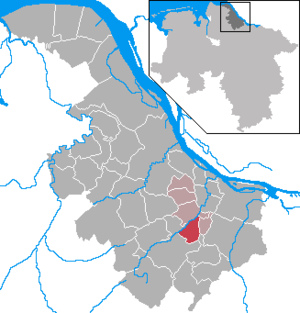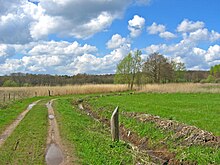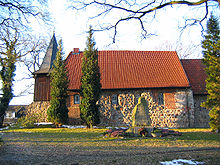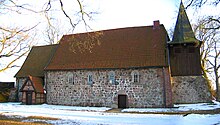Bliedersdorf
| coat of arms | Germany map | |
|---|---|---|
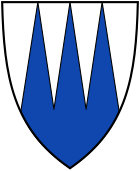
|
Coordinates: 53 ° 29 ' N , 9 ° 34' E |
|
| Basic data | ||
| State : | Lower Saxony | |
| County : | Stade | |
| Joint municipality : | Horneburg | |
| Height : | 25 m above sea level NHN | |
| Area : | 12.42 km 2 | |
| Residents: | 1781 (Dec. 31, 2019) | |
| Population density : | 143 inhabitants per km 2 | |
| Postal code : | 21640 | |
| Area code : | 04163 | |
| License plate : | HOURS | |
| Community key : | 03 3 59 007 | |
| LOCODE : | DE 2BV | |
| Community structure: | 3 districts | |
| Association administration address: | Lange Strasse 47–49 21640 Horneburg |
|
| Website : | ||
| Mayor : | Tobias Terne ( CDU ) | |
| Location of the municipality of Bliedersdorf in the Stade district | ||
Bliedersdorf ( Low German Bliersdörp ) is a municipality in the district Stade in Lower Saxony .
geography
location
Bliedersdorf is a neighboring village to the Aue , an underflow of the river called from Horneburg Lühe , which extends from before the town of Harsefeld and flows into the Elbe at Grünendeich .
The floodplain areas along the river in the area are leased by the Bliedersdorfer fishing club "Forelle", but they are often used as a recreation area by the Bliedersdorfer and visitors. Tribute has been paid since the late 1990s: The Auetal is now a nature reserve . Since floodplains often freeze over in winter when they are flooded, they create ideal ice-skating surfaces, with ditches running through the surfaces that are only safe when there is prolonged frost.
Administrative division
The municipality of Bliedersdorf belongs to the joint municipality of Horneburg and comprises the following neighboring districts ( villages ):
- Bliedersdorf (main town)
- Postmoor
- Rutenbeck
Postmoor and Rutenbeck, however, only make a small contribution to the population. Postmoor has also meanwhile been included in the Horneburg area and is therefore still controversial as a district.
history
Place name
Former place names of Bliedersdorf were 1236: de Blytherstorpe, 1238 de Blitherestrope, 1257 de Blidersdorp and 1257 de Blitherstorp. Low German -dorp; in the first part old personal name with the first link Blid-, which goes back to Old High German and Old Low German blidi, blide "happy, cheerful", such as Blidger, Blidgard, Blidfrid, Blithard, Blither, Blidhild, Blidram or Blidmar.
Population development
|
|
¹ census of June 6th
² census of May 27th
³ each December 31st

|
religion
Bliedersdorf is its own Lutheran congregation that the church district Buxtehude belongs. It is connected to Horneburg in a common parish office.
politics
Municipal council
The council of the municipality of Bliedersdorf consists of 10 members. This is the specified number for the member municipality of a joint municipality with a population between 1001 and 2000. The council is elected for five years in local elections. The current term of office began on November 1, 2016 and ends on October 31, 2021.
The mayor is also entitled to vote and sit on the council.
The last local elections resulted in the following distribution of seats immediately after the election:
| Local election | CDU | SPD | FWGB | total |
|---|---|---|---|---|
| 11th September 2016 | 6th | 3 | 2 | 11 seats |
| September 11, 2011 | 5 | 3 | 3 | 11 seats |
mayor
The mayor of the Bliedersdorf community is Tobias Terne (CDU). His deputy is Heinrich Klensang (CDU).
Chronicle of the mayor
|
|
(Source:)
coat of arms
In 1978 the community Bliedersdorf sought its own municipal coat of arms . The then mayor Herbert Feindt came across an old family coat of arms of the "Lords of Bliedersdorf." Thereupon the coat of arms was decided by the local council on February 26, 1979 and approved on August 2, 1979 by the district director of the Stade district.
| Blazon : "In silver three ascending blue tips ." | |
Justification of the coat of arms: In the chronicle of Bliedersdorf is mentioned:
|
Culture and sights
Buildings
- Katharinenkirche
- The church was built in 1240 by the knight Iwan von Bliedersdorf from the noble family of the "von Bliedersdorfs" after he took part in the "Stedinger" battles on the lower reaches of the Weser. The church is built entirely with field stones that fell from the surrounding fields. The walls are whitewashed. The construction of the church with its massive masonry and the small windows allows the conclusion that the church was also intended as a defensive structure. The position slightly raised above the rest of the village supports this hypothesis. In 1700 a half-timbered bridal house was added on the entrance side . The interior of the church is simple and artful at the same time. The pulpit from 1622 is a special piece of equipment. The family of the founders (the Christopher Richers family) is also shown under pictures of nature. The so-called “confessional” is also donated, a choir preaching which, with three seats, served the donors as a seat in the church after it had served its purpose as confession. Another special feature is the church ceiling, which was made by the schoolmaster at the time, "Teacher Sanny", and depicts rich tendrils and roses as decorations as well as two floating angels holding a medallion that represents the eye of God. The inscription around the eye writes: Do not sin O people whom God sees and the holy angels are everywhere around you . The bell tower, with wooden paneling over the fieldstone base, holds two bells from 1444 and 1625.
- Two legends surround the Katharinenkirche:
- 1. The Bliedersdorfer wanted to build a church. When they had found enough stones and lime they began their work. Day after day, teams of oxen on heavy wagons carried large amounts of lime and field stones up the hill on which the church was built. But how astonished the people of Bliedersdorf were when they noticed that the construction of their church had apparently been continued during the night. Angels were believed to be the invisible helpers. Nobody dared to doubt it. But two curious boys decided to hide near the construction site in the evening to overhear the angels at work. Said and done. But the poor were discovered, seized and walled into the church wall. The next morning only the tip of a jacket of the two boys was found peeking out of the wall .
- There is the modification that only a thumb was enclosed in the masonry.
- 2. Bliedersdorf had two bells with a wonderful sound. But when a need came over the village, it was decided to sell one of the two bells to Bargstedt . With an unspeakable effort, the bell was fetched from the tower and put on a wagon. Large beads of sweat and tears, even drops of blood dripped down, while all the horses in the town were barely able to get the car off the spot. In the evening you only came to Hohebrügge and left the car with the bell standing there. That night the Bliedersdorfer thought about keeping the bell. When they turned the car around, everything went by itself, the bell made it so easy for them. Others say the bell ran back to church that night alone. On the way you only saw the big, round prints where she jumped .
- The Evangelical Lutheran parish of Bliedersdorf is parishally connected to the Evangelical Lutheran parish of Horneburg. Your foundation aims to secure the parish office with its own pastoral office in the long term. It belongs to the Buxtehude parish and the Stade district. The parish has 1129 members.
- Every year on the 1st of Advent, the “Smallest Advent Market in Northern Germany” takes place at the Bliedersdorfer Church. Only Bliedersdorf products are offered there. In 2006 the Advent market celebrated its 20th anniversary. The proceeds will go to charity, which will be announced at the beginning of the Christmas market.
- This megalithic complex consists of four large barren beds and is located east of the village.
- Bliedersdorfer village fountain
- The village fountain is more than 200 years old and was rediscovered after around 70 years
-
Owned by the association “Bäuerliches Hauswesen Bliedersdorf e. V. "(BHB) there are currently six historical buildings:
- A village community bakery (half-timbered with brick roofing) relocated from Dollern , Stade district in May 2000. Inauguration in summer 2002.
- A sheepfold relocated from Helmste, Stade district in September 2002 (half-timbered with thatched roofing). Inauguration in autumn 2004.
- A drive-through barn relocated from Lengenbostel-Freetz, Rotenburg (Wümme) district in August 2008 (half-timbered with thatched roofing). Inauguration in spring 2010.
- A "small village smithy" (half-timbered structure with brick roofing) relocated from Rahmstorf, Harburg district in December 2008. Inauguration in spring 2010.
- A low German hall house from Hagen-Börsten, district of Cuxhaven, dismantled at the end of 1993 and stored in Hagen. Bought up in March 2003 by the “BHB” association (half-timbered) and stored in Bliedersdorf. The restoration of the framework started in October 2010. The work was completed in April 2012. The reconstruction took place on April 29, 2013 and the construction work was completed on April 30, 2014. The reconstruction of the hall building was preceded by the purchase of a 3500 m² adjacent plot of land from the Evangelical Lutheran parish of Bliedersdorf.
- A horizontal frame sawmill from Himmelpforten, Stade district, dismantled in September 2010 and stored in Bliedersdorf. A building application was drawn up in March 2015 and submitted to the Stade building authority. The permit was in place and reconstruction began in April 2016.
- New buildings
- There has been a new development area in Bliedersdorf since the beginning of 2008:
- On the site of the former Brüggmann sawmill, the municipality of Bliedersdorf has a new building area that is being marketed by a local developer. A good two thirds of the properties have currently been sold and one third has single-family and semi-detached houses.
Sports and clubs
Bliedersdorfer Sportverein 66 eV
Under the chairmanship of Björn Glüsen, the place maintains with the Bliedersdorfer Sportverein 66 e. V. , also called SV Bliedersdorf , has its own sports club, which is represented in the fields of gymnastics, gymnastics and athletics - in addition to the acceptance of the sports badge - and table tennis. The offer is complemented by a very successful Taekwon-Do team. The association has 750 members (as of 2010).
FSV Bliedersdorf / Nottensdorf
Up until the 2018/19 season, the main football division was also active under the name SV Bliedersdorf , although the club was active in the Stade district league, and in the meantime also in the Lüneburg 4 district league. From the 2019/20 season, the football club will play with FC after being re-established Nottensdorf 03 from the neighboring town of Nottensdorf together as FSV Bliedersdorf / Nottensdorf in the Stade district league.
In addition to the sports field in the center of the village, the Hexenkessel , there is also a very new facility, the Dohrenblick sports field , which was recently supplemented by a third sports field adjacent there. On this system u. a. the football club from its home games.
With the new construction of the Dohrenblick sports facility , it was possible to use part of the old Hexenkessel square in the center of the village for the construction of a skate area.
Other clubs
Various courses are also held in the village community center and in the sports hall in Horneburg .
With the Anglerverein Forelle e. V. Bliedersdorf from 1948, the village also offers a fishing club. Around 350 members have been fishing the waters in the surrounding area here since 1948, under the current chairmanship of Heino Wiemann. Among other things, the Aue and the Lühe .
The association Bäuerliches Hauswesen Bliedersdorf eV (BHB) was founded by 13 founding members in February 2000. Today the association already has 223 members, both active and passive. As a vigorous association, it has already left its mark in the village on the community's own property in Dohrenstrasse. Under the board of Rainer Kröger, the association has been taking on the task of maintaining and looking after old residential and functional buildings for several years now. The old bakery is operated several times a year at public gatherings. In addition, the space around the restored buildings is used for cultural events. The purpose of the association is to present the historical rural way of life and working methods. For this purpose, the construction of a half-timbered house community facility, consisting of relocated farmhouses on the grounds of the wedding forest in Bliedersdorf in Dohrenstrasse, is planned in the sense of monument protection. The task of the association is to initiate and carry out the necessary measures that are necessary to achieve the association's purpose. As a rural cultural asset, the half-timbered house community is intended to be a publicly accessible “living group of farmhouses” that characterizes the town and uses the premises for cultural purposes.
theatre
The Bliedersdorfer theater group has existed since 1967, which was created out of the village youth at the time. Since then, the Bliedersdorfer theater group has rehearsed and performed one or two Low German plays per year. Since the village community center existed, the performances have mainly taken place in winter on the stage located in it. The group consists of about 30 members who have made it their business to keep both the Volkstheater and the Low German language alive. The current director is Harry Löll.
Culinary specialties
Bliedersdorfer asparagus is widely known. Harvested in fields in and around Bliedersdorf, it is sold in a half-timbered farm that was the first to offer the service of peeling the asparagus.
Economy and Infrastructure
Public facilities
- Kindergarten "Ratz und Rübe"
- Village community center with restaurant, hall and bowling alley
- Sports field at the village community center, also known as the “witch's cauldron”, with a skater facility
- Dohrenblick sports facility (2 sports fields)
- Parish hall of the Evangelical Lutheran parish
- Fire station
- Home office in a three-tier house in Lower Saxony
education
- primary school
Personalities
Sons and daughters of the church
- Silke Meyer married. Schmitt (* 1968), national volleyball and beach volleyball player
- Klaas Nuttbohm (* 1984), American football player in the 1st Bundesliga and the national team
literature
- Christian Fuhst, Gerhard Burfeind: Bliedersdorf - How it became what it is - Chronicle of the village and church of Bliedersdorf . Dammann Verlag, Bliedersdorf 1988, ISBN 3-925076-13-1 .
- Christian Fuhst: The 750 year old stone church in Bliedersdorf. My confirmation time - sheets, results and pictures . Edition 1998/1999.
Web links
Individual evidence
- ↑ State Office for Statistics Lower Saxony, LSN-Online regional database, Table 12411: Update of the population, as of December 31, 2019 ( help ).
- ^ Jürgen Udolph (research): The "place name researcher". In: Website NDR 1 Lower Saxony . Archived from the original on August 17, 2014 ; accessed on August 3, 2019 .
- ↑ Ulrich Schubert: Community directory Germany 1900 - district of Stade. Information from December 1, 1910. In: gemeindeververzeichnis.de. January 5, 2020, accessed January 21, 2020 .
- ↑ a b c Michael Rademacher: German administrative history from the unification of the empire in 1871 to the reunification in 1990. Landkreis Stade ( see under: No. 12 ). (Online material for the dissertation, Osnabrück 2006).
- ↑ a b Statistisches Bundesamt Wiesbaden (ed.): Official municipality register for the Federal Republic of Germany - 1957 edition (population and territorial status September 25, 1956, for Saarland December 31, 1956) . W. Kohlhammer, Stuttgart 1958, p. 190 ( digitized version ).
- ↑ a b Federal Statistical Office (ed.): Historical municipality register for the Federal Republic of Germany. Name, border and key number changes in municipalities, counties and administrative districts from May 27, 1970 to December 31, 1982 . W. Kohlhammer, Stuttgart / Mainz 1983, ISBN 3-17-003263-1 , p. 246 .
- ↑ Lower Saxony State Administration Office (ed.): Municipal directory for Lower Saxony . Municipalities and municipality-free areas. Self-published, Hanover January 1, 1973, p. 46 , district of Stade ( digitized [PDF; 21.3 MB ; accessed on January 21, 2020]).
- ↑ a b c d e f g h i j community directory - archive - regional structure - annual editions - Lower Saxony. (All politically independent municipalities in EXCEL format). In: Destatis website. Federal Statistical Office, accessed on January 21, 2020 .
- ^ Lower Saxony Municipal Constitutional Law (NKomVG); Section 46 - Number of Deputies. In: Lower Saxony Regulations Information System (NI-VORIS). December 17, 2010, accessed January 21, 2020 .
- ↑ Announcement of the final results of the municipal elections on September 11, 2016. (PDF; 1.4 MB) In: Website Samtgemeinde Horneburg. September 16, 2016, accessed January 21, 2020 .
- ↑ Announcement of the final results of the municipal elections on September 11, 2011. (PDF; 40 kB) In: Website Samtgemeinde Horneburg. September 15, 2011, accessed January 21, 2020 .
- ↑ Lena Stehr: Tobias Terne is the new mayor in Bliedersdorf. In: Website Kreiszeitung Wochenblatt. December 26, 2017, accessed January 21, 2020 .
- ↑ Christian Fuhst, Gerhard Burfeind: Bliedersdorf - How it became what it is - Chronicle of the village and church of Bliedersdorf . Dammann Verlag, Bliedersdorf 1988, ISBN 3-925076-13-1 , p. Appendix E .
- ↑ a b Christian Fuhst, Gerhard Burfeind: Bliedersdorf - How it became what it is - Chronicle of the village and church of Bliedersdorf . Dammann Verlag, Bliedersdorf 1988, ISBN 3-925076-13-1 , p. 358 .
- ^ Main statute for the community of Bliedersdorf. (PDF; 78 kB) § 2; National emblem, official seal; Paragraph 1. In: Website Samtgemeinde Horneburg. November 7, 2016, p. 1 , accessed January 21, 2020 .
- ↑ a b Christian Fuhst: The 750 years old stone church in Bliedersdorf. My confirmation time - sheets, results and pictures . Edition 1998/1999.
- ↑ Football - Three Devils for Germany. In: Website Hamburger Morgenpost . July 15, 2005, accessed January 21, 2020 .

